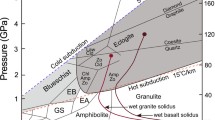Abstract
Fluids related to Serpentinization are of at least three types. The first reported (Barnes and O'Neil, 1969) is a fluid of local meteoric origin, the chemical and thermodynamic properties of which are entirely controlled by olivine, orthopyroxene, brucite, and serpentine reactions. It is a Ca+2-OH−1 type and is shown experimentally to be capable of reacting with albite to yield calcium hydroxy silicates. Rodingites may form where the Ca+2-OH−1 type waters flow across the ultramafic contact and react with siliceous country rock.
The second type of fluid has its chemical composition largely controlled before it enters the ultramafic rocks, but reactions within the ultramafic rocks fix the thermodynamic properties by reactions of orthopyroxene, olivine, calcite, brucite, and serpentine. The precipitation of brucite from this fluid clearly shows that fluid flow allows reaction products to be deposited at a distance from the point of solution. Thus, textural evidence for volume relations during Serpentinization may not be valid.
The third type of fluid has its chemical properties fixed in part before the reactions with ultramafic rocks, in part by the reactions of orthopyroxene, olivine, and serpentine and in part by reactions with siliceous country rock at the contact. The reactions of the ultramafic rock and country rock with the fluid must be contemporaneous and require flow to be along the contact. This third type of fluid is grossly supersaturated with talc and tremolite, both found along the contact. The occurrence of magadiite, kenyaite, mountainite, and rhodesite along the contact is probably due to a late stage low-temperature reaction of fluids of the same thermodynamic properties as those that formed the talc and tremolite at higher temperatures. Oxygen isotope analyses of some of these minerals supports this conclusion.
Rodingites form from Ca+2-rich fluids flowing across the contact; talc and tremolite form from silica-rich fluids flowing along the contact.
Isotopic analyses of the fluids indicate varied origins including unaltered local meteoric water and connate water. Complexion Spring water may be a sample of only slightly altered Jurassic or Cretaceous sea water.
Similar content being viewed by others
References
Barnes, I.: Metamorphic waters from the Pacific tectonic belt of the West Coast of the United States. Science 168, 973–975 (1970).
Barnes, I, Clarke, F. E.: Chemical properties of ground water and their corrosion and encrustation effects on wells. U. S. Geol. Surv. Profess. Papers 498-D (1969).
Barnes, I, O'Neil, J. R.: The relationship between fluids in some fresh alpine-type ultramafics and possible modern serpentinization, Western United States. Geol. Soc. Am. Bull. 80, 1947–1960 (1969).
Barnes, I., O'Neil, J. R.: Calcium-magnesium carbonate solid solutions from Holocene conglomerate cements and travertines in the Coast Range of California. Geochim. Cosmochim. Acta 35, 699–718 (1971).
Barnes, I., O'Neil, J. R., Rapp, J. B.: Silica-carbonate alteration of serpentine: wall rock alteration in mercury deposits of the California coastal ranges. In preparation.
Bricker, O. P.: Stability constants and Gibbs free energies of formation of magadiite and kenyaite. Am. Mineralogist 54, 1026–1033 (1969).
Coleman, R. G.: Low-temperature reaction zones and alpine ultramafic rocks of California, Oregon, and Washington. U. S. Geol. Surv. Bull. 1247 (1967).
Coleman, R. G.: Petrologic and geophysical nature of serpentinites. Geol. Soc. Am. Bull. 82, 897–918 (1971).
Eugster, H. P., Jones, B. F., Sheppard, R. A.: New hydrous sodium silicates from Kenya, Oregon, and California: Possible precursors of chert. In: Abstracts for 1967, Geol. Soc. Am. Spec. Papers 115, 60–61 (1968).
Feth, J. H., Rogers, S. M., Roberson, C. E.: Aqua de Ney, California, a spring of unique chemical character. Geochim. Cosmochim. Acta 22, 75–86 (1961).
Fontes, J. C., Gonfiantini, R.: Comportement isotopique au cours de l'evaporation de deux bassins Sahariens. Earth Planet. Sci. Letters 3, 258–266 (1967).
Gude III, A.J., Sheppard, R. A.: Hydrous sodium silicate minerals, Trinity County, California. Abstracts for 1969, Geol. Soc. Am. part 7, p. 86 (1969).
Harder, H., Flehmig, W.: Quarzsynthese bei tiefen Temperaturen. Geochim. Cosmochim. Acta 34, 295–305 (1970).
Hostetler, P. B., Coleman, R. G., Mumpton, F. A., Evans, B. W.: Brucite in alpine serpentinites. Am. Mineralogist 51, 75–98 (1966).
Kitahara, Shigeto: The polymerization of silicic acid obtained by the hydrothermal treatment of quartz and the solubility of amorphous silica. Rev. Chem. Japan 30, 131–137 (1960).
Luce, R. W.: Brucite identified as crystallizing from a natural cold alkaline spring gel. Clays Clay Minerals 19, 335–336 (1971).
Morey, G. W., Fournier, R. O.: The decomposition of microcline, albite, and nepheline in hot water. Am. Mineralogist 46, 688–699 (1961).
O'Neil, J. R., Barnes, Ivan: C13 and O18 compositions in some freshwater carbonates associated with ultramafic rocks and serpentinites: Western United States. Geochim. Cosmochim. Acta 35, 687–697 (1970).
O'Neil, J. R., Hay, R. L.: O18/O16 ratios of cherts associated with the saline lake deposits of East Africa. Trans. Am. Geophys. Union 52, 362 (1971).
Ryzhenko, B. N.: Determination of hydrolysis of sodium silicate and calculation of dissociation constants of orthosilicate acid at elevated temperatures. Geochemistry Internat. 4, 99–107 (1967).
Savin, S. M., Epstein, S.: The oxygen and hydrogen isotope geochemistry of clay minerals. Geochim. Cosmochim. Acta 34, 25–42 (1970).
Thompson, J. B., Jr.: Local equilibrium in metasomatic processes. In: Researches in geochemistry (P. H. Abelson, ed.). New York: Wiley 1959.
White, D. E., Barnes, I., O'Neil, J. R.: California waters of non-meteoric origin. Geol. Soc. Am. Program 3, 750 (1972).
Author information
Authors and Affiliations
Additional information
Publication authorized by the Director, U.S. Geological Survey.
Rights and permissions
About this article
Cite this article
Barnes, I., Rapp, J.B., O'Neil, J.R. et al. Metamorphic assemblages and the direction of flow of metamorphic fluids in four instances of serpentinization. Contr. Mineral. and Petrol. 35, 263–276 (1972). https://doi.org/10.1007/BF00371220
Received:
Issue Date:
DOI: https://doi.org/10.1007/BF00371220




